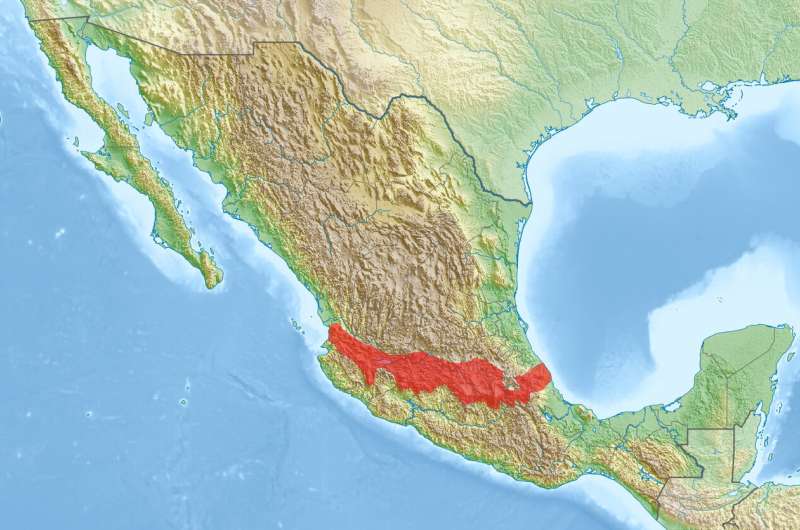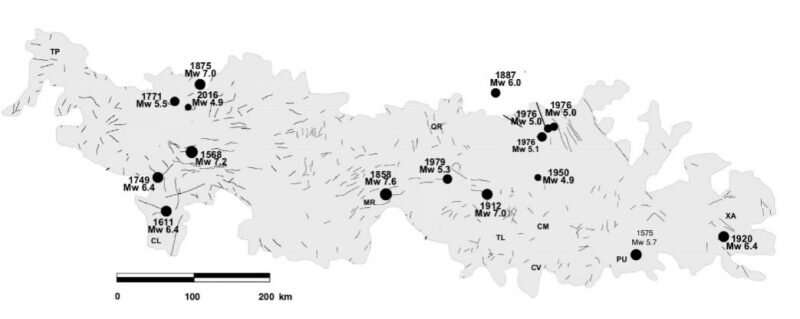Historic earthquakes suggest Trans-Mexican Volcanic Belt's quiet regions are active

Seemingly low-hazard seismic regions in Mexico have experienced multiple, strong earthquakes since the 1500s, new research finds, suggesting the regions have many unmapped, active fault lines. The areas are inside the Trans-Mexican Volcanic Belt, home to roughly 40 percent of Mexico's population, who may be unaware of the land's seismic history.
New research collected archival records documenting the belt's historic earthquakes, converting the historic reports into numerical data. The new study in the AGU Journal Tectonics found there have been at least 16 large earthquakes during the past 450 years in areas of the belt previously believed to be dormant, challenging an existing understanding of the belt's behavior.
"Instrumental seismology spans a little over 100 years, but this phenomenon takes place at geological times. If we want to understand what's really happening in the Earth… then we really need to go back and see what's happened," said Gerardo Suárez, a seismologist at the National Autonomous University of Mexico in Mexico City, Mexico, and lead author of the new study.
The Trans-Mexican Volcanic Belt is a 1000-kilometer (621-mile) long volcanically tectonic active region stretching from the Gulf of Mexico to the Pacific Ocean across Central and South Mexico. It is home to many urban centers, including Mexico City.
Seismic hazard is the probability that an earthquake could occur in a region over a specific time frame. Scientists assumed that the seismic hazard in the Trans Mexican Volcanic belt was low because there were not many documented earthquakes.
Even if a region hasn't had earthquakes for a century, it still could be seismically active. Suárez suspected the belt's areas without visible faults, like its central and western region, could have had earthquakes in the past because missionaries, colonial government officials and Aztec codices recorded descriptions of tremors, landslides and fractures in the region. Before the widespread use of earthquake recording equipment, earthquakes in the past are identifiable only through written accounts.
Understanding the history of earthquakes inside the Trans Mexican Volcanic belt could help alert people living in the region to the potential seismic hazard there, according to the study's authors.

Using history to find hidden fault lines
The researchers collected historical records from Mexican archives, using them to classify individual earthquakes from 1568 to 1920. They selected 16 earthquakes with enough recorded sites and reported damage to qualify for the study.
An Aztec codex called the Anales de Tlatelolco, for example, recorded seismic activity for more than four days in 1575. One of the villages where the earthquake was felt, named Zacaetotlán, is nowhere to be found in modern Mexico. Another manuscript hints that Zacaetotlán was a pre-Hispanic settlement found near a volcano in the belt's central region. The town's ruins have never been found.
In another example, a 7.6-magnitude earthquake struck the state of Michoacán in 1858. Its epicenter was in a city called Morelia in the center of the volcanic belt. Documents from the time attest to its devastating aftermath in the state. The same earthquake also struck Mexico City roughly 200 kilometers (124 miles) away. The city hall and other government buildings were damaged, as well as aqueducts.
Suárez and his colleagues converted the archival testimonies into numerical values using the Modified Mercalli Intensity Scale, a seismologic method that ranks earthquakes by the intensity of the damage or by how it was felt by the population. Earthquakes that are "severe" might move furniture, while "violent" earthquakes cause building collapse. The scale helped the scientists use the reports of damage to assign each earthquake an intensity data point and then estimate the magnitude and epicenter using a numerical approach.
Results showed earthquakes have happened throughout the Trans-Mexican Volcanic Belt, even in areas thought to be geologically inactive. These earthquakes were particularly common in the central and western regions of the volcanic belt. Several of them are associated with blind faults, or faults that aren't visible on the Earth's surface, according to the study.
"We should expect earthquakes throughout the volcanic belt even in areas where we have not yet been able to map active tectonic faults," Suárez said.
More information: Gerardo Suárez et al. Active Crustal Deformation in the Trans Mexican Volcanic Belt as Evidenced by Historical Earthquakes During the last 450 Years, Tectonics (2019). DOI: 10.1029/2019TC005601
Provided by American Geophysical Union
This story is republished courtesy of AGU Blogs (http://blogs.agu.org), a community of Earth and space science blogs, hosted by the American Geophysical Union. Read the original story here.


















